Key to vision preservation: Understanding the relationship between glaucoma and NAD+
The prevalence of glaucoma is increasing globally, and the effectiveness of existing treatments is limited.
Professor Chiarugi of the University of Florence proposes an innovative therapeutic strategy based on NAD+ precursors to slow vision loss by increasing NAD+ levels within the RGC axon.
Clinical trials are verifying its effectiveness, and NAD+ precursor supplements are expected to become a new treatment option for glaucoma.
The prevalence of glaucoma is rising and is expected to affect about 11 million patients over the next decade.
Worryingly, 9 to 12 percent of these patients may develop blindness.
While surgical intervention to reduce intraocular pressure (IOP) has not yielded significant results in alleviating glaucomato-related visual impairment and blindness, a new line of research offers hope for the treatment of glaucoma.
This breakthrough idea stems from the research of Alberto Chiarugi, clinical professor of pharmacology and Oncology at the University of Florence, who has proposed an innovative therapeutic strategy based on NAD+ precursors.

Causes of glaucoma: transcending intraocular pressure
The traditional view is that the main cause of glaucoma is increased eye pressure, and Professor Chiarugi’s research shows that the deterioration of retinal ganglion cell (RGC) axons is the core problem of glaucoma. Located at the back of the eye, these axons are sensitive to light and are important channels for visual information transmission.
In experiments with mice, Chiarugi found that the layered structure at the back of the eye (sieve plate) obstructs the transport of nutrients to the RGC axon.
This structure restricts the flow of essential nutrients and mitochondria, especially the transport of the NAD+ synthetase NMNAT2, resulting in reduced levels of NAD+ within the axon.
Since the RGC axons not protected by myelin and require more energy to maintain signaling, the β-nicotinamide adenine dinucleotide deficiency eventually leads to the degeneration of the axons.
NAD+ : The key to vision protection
Professor Chiarugi’s research has shown that by supplementing NAD+ precursors, such as niacinamide (NAM), NAD+ levels within RGC axons can effectively raised, thereby slowing or even reversing vision loss caused by glaucoma.
In one human study, supplementation with 1.0 to 3.0 grams of NAM and 1.5 to 3.0 grams of pyruvate per day resulted in significant improvement in vision in glaucoma patients after three weeks.
A three-year study followed 5,780 participants and found that increasing dietary niacin intake by 28 mg per day significantly reduced the odds of glaucoma attacks.
These findings suggest that NAD+ precursor supplements have great potential in preventing and treating glaucoma.
Hope for the future: ongoing clinical trials
Multiple clinical trials are underway to further validate the effectiveness of NAD+ precursors. For example, a 24-month study is evaluating the effects of a 300 mg daily nicotinamide ribose (NR) supplement on light-sensing ability in different areas of the visual field in patients with glaucoma.
Other trials are also exploring whether daily oral administration of NAM or pyruvate alone can slow the progression of glaucoma.
The results of these clinical trials will provide a more solid scientific basis for the application of NAD+ precursor supplements, further consolidating its position in the treatment of glaucoma.
Experimental verification and market prospect
In addition to human trials, animal studies also provide strong evidence. In mouse models, supplementation with NAD+ precursors significantly increased NAD+ levels in RGC axons and improved their function.
These experimental results complement human studies showing the potential of NAD+ precursors in protecting and restoring vision.
In the market, NAD+ precursor supplements have begun to receive attention.
Several well-known health product companies have launched products containing NAM and NR to address the market demand for the prevention and treatment of glaucoma. These products have not only well received by consumers, but also aroused widespread concern in the medical community.
Scenario application: Everyday choice for vision protection
For patients with glaucoma and those at high risk, daily supplementation with NAD+ precursors could serve as a simple and effective means of prevention and treatment.
Middle-aged and elderly people can increase the intake of niacin in their daily diet, or choose health products containing NAM and NR. These supplements can not only help maintain vision, but also promote overall health.
Ophthalmologists can recommend that high-risk patients try NAD+ precursor supplements during routine exams to reduce the risk of glaucoma attacks.
This preventive measure is simple, scientifically based and can significantly improve patients’ quality of life.
Sum up
With the increasing prevalence of glaucoma, the search for effective treatment has become particularly important.
Professor Alberto Chiarugi’s research opens up an entirely new avenue for glaucoma treatment, by supplementing NAD+ precursors such as NAM and NR, it can effectively increase NAD+ levels within the RGC axon, slowing or even reversing glaucoma-induced vision loss.
With the development of clinical trials and the promotion of the market, NAD+ precursor supplements expected to become the standard regimen for glaucoma treatment, bringing benefits to millions of patients.



